
The Great Central Railway in England came into being when the Manchester, Sheffield and Lincolnshire Railway changed its name in 1897, anticipating the opening in 1899 of its London Extension. On 1 January 1923, the company was grouped into the London and North Eastern Railway.

The Great Northern Railway (GNR) was a British railway company incorporated in 1846 with the object of building a line from London to York. It quickly saw that seizing control of territory was key to development, and it acquired, or took leases of, many local railways, whether actually built or not. In so doing, it overextended itself financially.
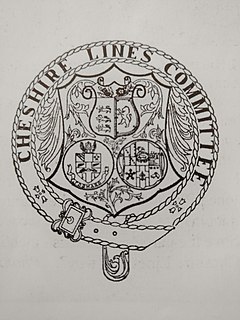
The Cheshire Lines Committee (CLC) was formed in the 1860s and became the second-largest joint railway in Great Britain. The committee, which was often styled the Cheshire Lines Railway, operated 143 miles (230 km) of track in the then counties of Lancashire and Cheshire. The railway did not get grouped into one of the Big Four during the implementation of the 1923 grouping, surviving independently with its own management until the railways were nationalised at the beginning of 1948. The railway served Liverpool, Manchester, Stockport, Warrington, Widnes, Northwich, Winsford, Knutsford, Chester and Southport with connections to many other railways.
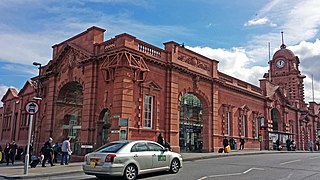
Nottingham station, briefly known as Nottingham City and for rather longer as Nottingham Midland, is a railway station and tram stop in the city of Nottingham. It is the principal railway station of Nottingham. It is also a nodal point on the city's tram system, with a tram stop that was originally called Station Street but is now known as Nottingham Station.
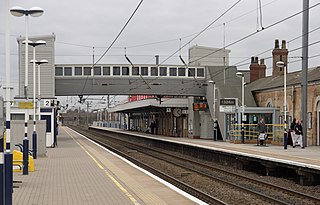
Newark Northgate railway station is on the East Coast Main Line in the United Kingdom, serving the town of Newark-on-Trent, Nottinghamshire. It is 120 miles 8 chains (193.3 km) down the line from London King's Cross and is situated on the main line between Grantham to the south and Retford to the north. The station is Grade II listed.

Barnsley Interchange is a combined rail and bus station in the centre of Barnsley, South Yorkshire. It was first opened in 1850 as Barnsley Exchange railway station and is 16 miles (26 km) north of Sheffield. It is on the Hallam and Penistone Lines, both operated by Northern Trains. On 20 May 2007, the new bus station and refurbished railway station were officially opened by Travel South Yorkshire, with the combined facility renamed to Barnsley Interchange.
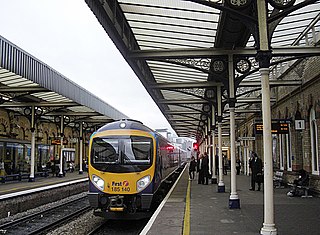
Warrington Central railway station is one of two main railway stations serving the town of Warrington in the north-west of England. It is located on the southern route of the Liverpool to Manchester Lines, being situated approximately halfway between the two cities. Central station is served by diesel stopping trains between Liverpool and Manchester, and diesel express services between Liverpool and Manchester Airport, as well as between Liverpool and East Anglia.

Nottingham Victoria railway station was a Great Central Railway and Great Northern Railway railway station in Nottingham, England. It was designed by the architect Albert Edward Lambert, who also designed the rebuild of the Nottingham Midland station.
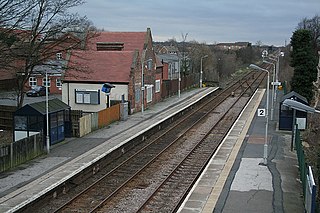
Bingham railway station serves the market town of Bingham, Nottinghamshire, England. The station is 8½ miles (14 km) east of Nottingham on the Nottingham-Skegness Line. The station is operated and served by East Midlands Railway.
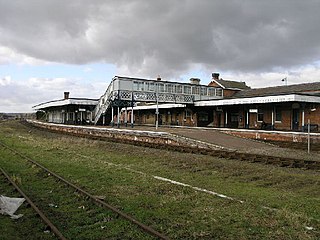
Sleaford railway station serves the town of Sleaford in Lincolnshire, England. It lies on the Peterborough–Lincoln line. The station is 21.25 miles (34 km) south of Lincoln Central.

The Great Central Main Line (GCML), also known as the London Extension of the Manchester, Sheffield and Lincolnshire Railway (MS&LR), is a former railway line in the United Kingdom. The line was opened in 1899 and built by the Great Central Railway running from Sheffield in the North of England, southwards through Nottingham and Leicester to Marylebone in London.

Ruddington is a disused railway station on the Great Central Main Line south of Nottingham. The line had branches that ran to the now decommissioned Ruddington Depot.

Nottingham Arkwright Street was a railway station in Nottingham on the former Great Central Main Line which ran from Manchester Piccadilly to London Marylebone. The station opened with the line in 1899 and closed in 1963 as part of rationalisation; it reopened four years later upon the closure of Nottingham Victoria railway station, only to close in 1969.

Nottingham London Road railway station was opened by the Great Northern Railway on London Road Nottingham in 1857.
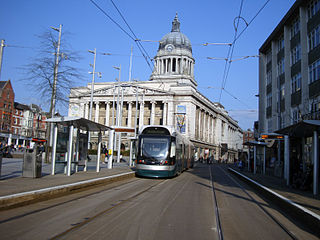
Nottingham is the seventh largest conurbation in the United Kingdom. Despite this, the city had a poor transport system in the 1980s. The government has in the early twenty-first century invested heavily in the transport network of Nottingham, which has led to the re-opening of the Robin Hood Line and the construction of a light rail network, Nottingham Express Transit.
The Ambergate, Nottingham and Boston and Eastern Junction Railway was a British railway company, which hoped to connect Lancashire with the port of Boston, in Lincolnshire. It was authorised in 1846 but was unable to raise much money. It opened a standard gauge line from a junction near Nottingham to Grantham in 1853. At Nottingham it was to rely on the Midland Railway, but that company was hostile and obstructive.

Bulwell Common railway station was a station in Nottingham on the Great Central Railway main line, the last main line to be built from the north of England to London. The station opened with the line on 15 March 1899.
The Nottingham Suburban Railway was a British railway company that constructed a line 3.65 miles in length serving the north-eastern suburbs of Nottingham. It was built to shorten the distance by train to Ilkeston and towns on the Leen Valley railway line, and to connect important brickworks near Nottingham. The short line was expensive to build due to difficult topography; it opened in December 1889, and was worked by the Great Northern Railway; the trains used that company's Nottingham terminus.

The Mansfield Railway was an eleven-mile railway line in Nottinghamshire, England. It was built to serve collieries opening in the coalfield around Mansfield, and ran between junctions at Clipstone and Kirkby-in-Ashfield on the Great Central Railway. It opened in 1916 and was worked by the GCR. Passenger stations were opened on the line, although, at the date of opening, road bus competition was already dominant.
















